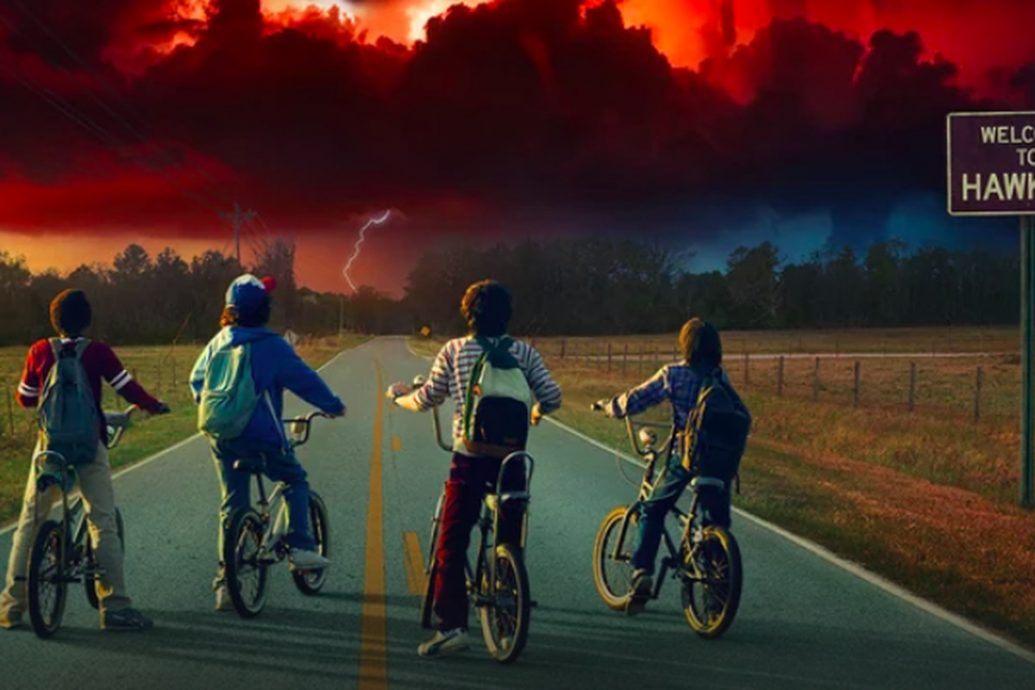Using therapeutic regression for cover, the Duffer Brothers manage to tell a great story.
Un-strange Virtues Celebrated in Stranger Things
Stranger Things, the hit series on Netflix, is a show that celebrates the vital center in modern American culture. Inspired by the 1980s fiction of Stephen King and the 1980s films of Steven Spielberg, the show is loved for the way its creators Matt and Ross Duffer have nailed the music, clothes, and tone of the Reagan era. Yet thematically, Stranger Things more accurately echoes the philosophy of Jaws, the 1975 Spielberg film that champions middle-class values that stand between the cultural Left and outdated notions of masculinity.
At the center of the show is the rescue of a boy named Will Byers (Noah Schnapp), who goes missing while bicycling home from playing the board game Dungeons and Dragons with his friends. Will’s mother Joyce (Winona Ryder) and brother Jonathan (Charlie Heaton) search for the boy, joined by Will’s friends Mike (Finn Wolfhard), Dustin (Gaten Matarazzo), and Lucas (Caleb McLaughlin). They are helped by Chief Jim Hopper (David Harbour), the sheriff of Hawkins, Indiana, the small town where Stranger Things takes place.
Joyce discovers that she can hear Will trying to communicate with her through the walls of her house. He has tumbled into an inter-dimensional realm, the “Upside Down,” inhabited by a monster called Demagorgon who can now enter our world. Then an odd and mostly mute girl named Eleven (Millie Bobby Brown) appears. Eleven is attempting to evade an evil scientist from the government, Dr. Martin Brenner (Matthew Modine), who has been conducting LSD experiments on her. Eleven can move objects with her mind. (Each season of Stranger Things has eight episodes, so things get complicated.)
The show’s co-creators are open and obvious about their love of horror movies and fiction from the 1980s. Its verisimilitude about the time period and the work of King, Spielberg, and also George Lucas of Star Wars and the horror master John Carpenter is impressive. Their plot, which has a group of cute and nerdy kids discovering something magical or dangerous from another world, only to find themselves stuck between the creature (or the treasure) and the authorities, is an obvious homage to films like E.T. the Extra-Terrestrial (1982), The Goonies (1985), and Stand by Me (1986).
Yet the pop culture work that Stranger Things might owe the most to is Jaws, which Spielberg made in 1975 from a 1974 novel by Peter Benchley. Considered Spielberg’s first great movie, Jaws is about a seaside resort town being terrorized by shark attacks as the police chief’s warnings about the danger go unheeded. In both films, kids are at risk from a devouring monster from another realm, and protection is slow in coming owing to governmental incompetence or malevolence. The hero of both is a police officer who bears psychic wounds but who is strong enough to challenge the authorities and then hold the line against an existential predator.
Chief Martin Brody in Jaws and Chief Hopper in Stranger Things are similar. Both are wounded and vulnerable, yet have a core of strength and decency. Brody is afraid of the water, and Hopper is in Hawkins after a broken marriage and a failed attempt to be a “big city cop.”
Brody, played by Roy Scheider, represents the Silent Generation, those who fought in Korea, don’t complain, and strive for a simple middle-class life. He is 42, too young to have fought in World War II and too old to be a hippie. Hopper is around that age and a member of Generation X, the group of Americans considered by some to be the ones standing between the self-indulgent baby boomers and the technology-addicted millennials. Both show an abundance of common sense, in Brody’s case redolent of the “vital center” of pragmatic liberalism, and in Hopper’s the hard-won realism, or neoconservatism, that accepts the limits of the world as it is.
Both men realize their inner strength when they are called upon by conscience—and by undeniable evidence, no matter what the skeptical townsfolk might say—to surmount their fears in the defense of children. Read politically, these characters could be said to represent, respectively, the worldviews of John F. Kennedy and Ronald Reagan—a pro-American stance between the far Right and the punitive Left.
The film critic Peter Biskind, in a brilliant (if sometimes over-the-top) 1975 essay, places Jaws at the center of mainstream liberalism—a liberalism positioned “between the teeth” (get it?) of the New Left and the Old Right. He calls Jaws “a middle-class Moby Dick.” Whereas Herman Melville’s classic “is a bleak and pessimistic epistemological allegory,” Jaws is “a tale of liberalism at sea, barely afloat in shark-infested waters, but nevertheless afloat. It is ultimately cathartic and comforting.” The monster shark in Jaws is destroyed by Chief Brody, “a small town police chief possessed of all the middle-class virtues.” After killing the beast, Brody “dog-paddles home to shore, wife, and family.”
Biskind finds symbolic relevance in who gets killed in Jaws, an insight that is illuminating for Stranger Things. At the beginning of Jaws, a stoned hippie girl invites a man into the ocean to have sex. He passes out on the beach and she is devoured by a great white. At the climax of the film, Quint, a tough old sea salt (played to perfection by Robert Shaw) is also eventually gulped down by the mammoth fish. Biskind considers the deaths of these opposites significant. “In line with the film’s conservative domesticity,” he says, the young woman is “being punished for her sexual freedom and her forwardness (she invites him to follow her), both of which overturn the conventional sex roles that [Jaws] is at pains to affirm.”
Stranger Things has this, but with a 1980s twist. Nancy Wheeler (Natalia Dyer), who has taken an interest in Will’s disappearance, is invited to swim at a boy’s house, and she drags along her nervous and virtuous best friend Barbara Holland (Shannon Purser) for company. While Nancy and the boy have sex in the house, Barbara, who is sitting by a pool (an echo of the water element in Jaws), is kidnapped and killed by the Demagorgon from the Upside Down. Sexually active teens getting dispatched by a masked maniac was a staple of 1980s horror movies; now, however, it is not the promiscuous teen (or drugged-out bohemian) who falls, but the well-behaved virgin. In the 1980s, the era of AIDS and STDs, you were liable to become a victim simply by being in proximity to sexual activity. Things have only gotten more dangerous in the modern era of social media.
Then there is Quint, Jaws’s large, intimidating, foul-mouthed, and recklessly brave shark-hunter. “Quint is an anachronism,” Biskind observes, “a composite of the last vestiges of ruthless Yankee self-reliance, traces of working class pride, and a touch of New England transcendental madness, a true spiritual heir of Ahab.” For this unruliness Quint must die. He is “too powerful, too independent of traditional social ties, too prone to excess—and he pays for it.” Given how disrespectful he is of authority, and the fact that he “extorts $10,000 from the desperate town council to kill the great white,” he is “nearly as dangerous to the social fabric of Amity as the shark itself.”
In a line that finds echoes in the man occupying the Oval Office today, Biskind notes that
from the point of view of the film’s comfortable liberalism, Quint’s combination of working class toughness and bourgeois independence is alien and frightening. He is viewed as irrational and out of control. Authority must be restored, but not by Quint.
And here the comparison between the 1975 movie and 2017 television show breaks down, for there’s no character similar to Quint in Stranger Things. This is perhaps not surprising—remember that the critic qualified Quint as an anachronism even back then. His type is truly gone from our midst; today’s alt-Right macho men are cartoon versions of his insouciant bravery. (The racists torch-carriers in Charlottesville would have been loudly mocked by Quint.)
In Stranger Things there are no macho men, with male aggression being portrayed through school bullies and Joyce’s menacing ex-husband, a roadblock to solving the crime. Due to its 1980s setting, the show doesn’t feel obligated to make its main characters minorities or gay, or to send leftist messages, covertly or not, to the audience. The heroes of Stranger Things, like Chief Brody in Jaws, display simple American perseverance and common sense. They are suspicious of big government and large corporations, but in a world where liberalism has not curdled into speech codes and racial hectoring. This is a show that finds salvation in the quiet virtues of regular folks: kids, the Byer family, and Chief Hopper.



